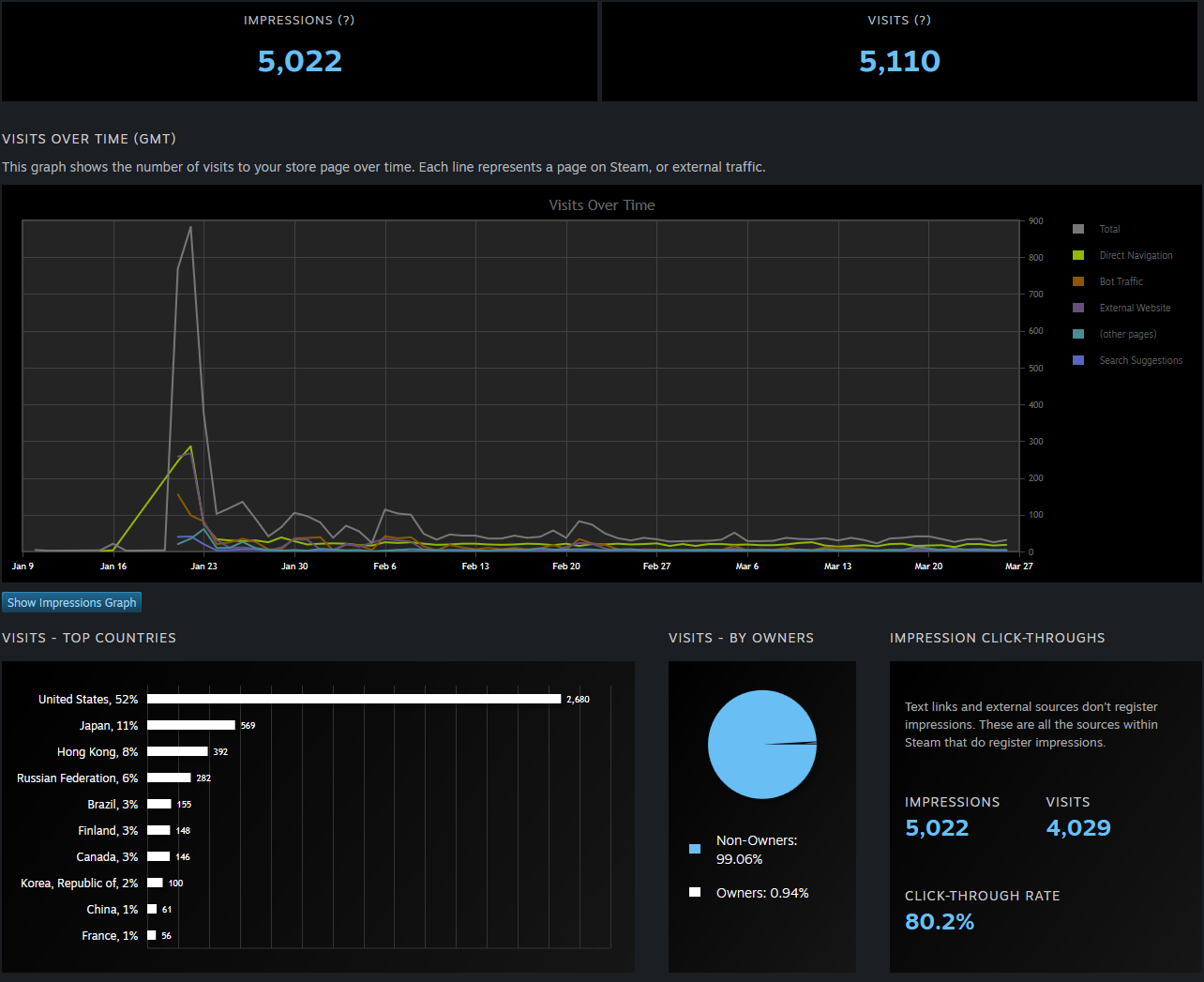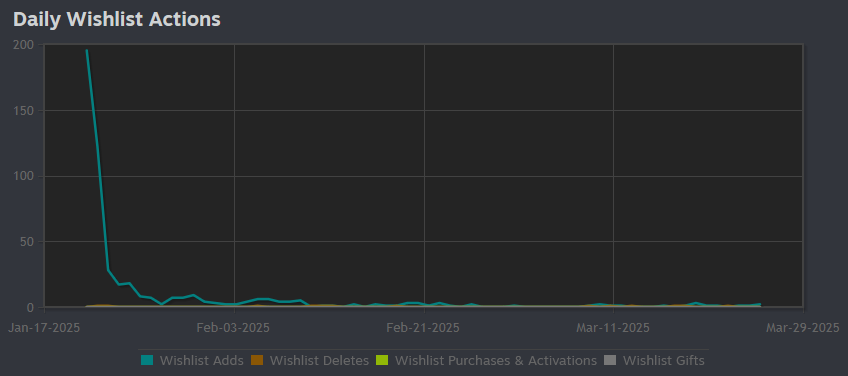Low-Budget, High Hopes: Marketing Marras to Shmup Fans and Beyond
All images (in exception of Steam graphs) courtesy of Karhukuvat
The past few weeks have been rough for MARRAS’ development. My day job as a software engineer has drained me, sapping my mental energy for game development after hours. To top it off, as soon as I cleared the most pressing tasks at work, I caught the flu. I’ve spent the last few days (re-re-re)watching Twin Peaks, my nights plagued by fever dreams straight out of the show’s surreal world (Let’s rock!). The recent passing of David Lynch hit me harder than I anticipated. Words can’t fully capture my admiration for the maestro, his films, drawings, acting, weather reports, and beyond. We’ll miss you, David. See you at the curtain call.
A Short Development Status Report
Despite the setbacks, I’ve snatched a few moments for game development. I’ve notched small wins with menus, audio manager components, and game flow. Rudimentary save and user preferences/config systems are in place, though they’ll evolve as the project grows. Once again, I’m reminded of how much effort goes into basic features that don’t directly tie to gameplay. The upside? Having menus, settings, and other essentials ready for early demos frees me up to refine them alongside gameplay later. Some tasks, like menus, feel mundane and obligatory, while others spark genuine joy. I’m thankful I can switch between them based on my mood and energy levels.
But that’s not the focus of today’s post. Let’s talk marketing.
Purpose of This Post
This blog aims to explore the indie game development journey, specifically for a shoot 'em up, from a marketing lens. While many principles here apply broadly, the challenges I’ll highlight are unique to the shmup genre. This post spans various topics, some potentially divisive. I’m a developer first, not a marketing guru. What follows blends my opinions, observations, speculations, and ideas—some original, others inspired by discussions I’ve had or overheard and agree with. Take it with a grain of salt, as with most online content. To keep things digestible, I’ll stick to high-level thoughts. Want a deep dive into any part? Let me know!
Part 1. Introduction to Marketing an Indie Game
Marketing isn’t a final checkbox—it’s a thread woven through the entire development process. Even picking a genre is a marketing choice. It’s also distinct from advertising, though the two are often conflated. Advertising boosts visibility, but not every game is “advertisable”. A game must be solid first—pushing a subpar product won’t salvage it. Too many developers dodge self-reflection when their game flops, blaming poor marketing when the real issue might be the quality of the product they are trying to market.
Your approach hinges on your goals. If you’re crafting a game as a hobby or art form, marketability might not matter. If profit’s the aim, it should shape your genre, style, and content. I fall somewhere in between, tilting toward hobby and art.
With MARRAS, I face a dual reality. Shmups are a tough sell from a marketability standpoint. Still, I’ve woven in elements to broaden its appeal without alienating its core audience: the shoot ‘em up community. I don’t expect MARRAS to replace my day job’s income—software engineering already supports my family comfortably. But in a world overflowing with entertainment options, marketing is non-negotiable if you want anyone to notice your game. Hoping it “markets itself” is a gamble on luck. While marketing has no magic formula and luck plays a role, proactive effort shrinks that reliance on chance. It’s like boosting your odds with the same lottery ticket—your game. Up to a point, the best time investment is making the game itself more marketable. Without marketing, though, you’ve got no shot.
Marketing Design Choices for MARRAS
From a marketing-driven design perspective, here’s my approach with MARRAS:
Build a game inspired by titles I love and others do too.
Keep core gameplay faithful to these references, honoring the genre’s legacy and principles.
Include features modern shoot 'em ups need.
Avoid unnecessary “innovations” in core gameplay—deliver what shmup fans expect, not a “reimagined” genre. There’s no need for that.
Take creative risks with graphical assets and style, blending high-fidelity visuals with a classic pre-rendered pipeline for a personal touch.
Provide a novice-friendly way to experience the core gameplay without diluting the arcade experience that shoot 'em up players expect. Introduce a separate mode with a structure that appeals to an audience that hasn’t yet found ways to enjoy shooting games.
Include a top-tier training system to teach newcomers the basics of shooting games.
Never settle for a subpar product.
Part 2. Shmup Market Situation and Expectations (the minimalistic edition)
The shmup market is a brutal beast to tame. Consider our indie darlings purely from a marketing and sales perspective:
Blue Revolver’s sales are so low that it’s almost criminal.
Gunvein falls in the same category as Blue Revolver
ZeroRanger outperforms most shooting games. Its creators, Ebbo and Ebrozgi, are legends in my book. If shmups were mainstream, they’d also be millionaires (maybe they are, but not due to shoot ‘em up sales).
Newcomers like Angel at Dusk and Devil Blade Reboot shine, but still struggle commercially compared to mainstream genres
Touhou is an exception. Its fandom supports it beyond games, despite declining game quality.
Realistic Shmup Engagement and Sales
Are low sales due to weak marketing, no advertising, or low demand? At best, shoot ‘em ups underperform without broader appeal. The genre doesn’t naturally draw crowds, not because it’s bad or overly niche, but because developers haven’t cracked a way to package it for modern players. Too often, the blame falls on players for not “getting” shmups, rather than scrutinizing the games or genre itself. Here’s how I feel about it:
Broad appeal can’t be forced.
Expanding the genre’s reach requires change.
That change must come from someone who gets shmups’ DNA—otherwise, you get misfires like Cygni.
That someone also needs to grasp what modern players want and why the shooting game's steep learning curves turn most people off.
For many shooters, chasing the wider appeal after sales has ruined the whole experience of the game by not understanding what makes a good shoot 'em up. Modern shmups with a bit wider appeal, like ZeroRanger or Blue Revolver, share traits: rock-solid gameplay, coherent style, and a balance of accessibility and authenticity. It’s not about dumbing it down; it’s about inviting more players to the party. Broader appeal doesn’t guarantee a jackpot, but it’s the best shot at turning a niche passion into something that resonates beyond the arcade faithful. And that's where, eventually, the money and sustainability for long-term game development funding lie.
Bridging the Gap: Understanding Modern Audiences and shoot ‘em up Passion
The most painful thing for me has been the understanding that modern audiences, in general, don’t care about the same things I might find the most interesting and coolest ever. They don’t care about Garegga’s rank system, DoDonPachi’s chaining, or Ikaruga’s brilliance (despite its frequent praise in traditional media). World records, CRTs, PCBs, candy cabs, secret scoring tricks, or 2-ALL 1CCs? Most shrug. Some might dive in eventually, but the majority won’t. And that’s okay!
Here’s the thing, though: the more people we can get to try the shmup genre, the greater the chance we’ll see some of them stick around and make it their own. It’s a numbers game at heart. Not everyone will care about chaining combos or mastering a rank system—and they don’t have to—but even a small fraction of newcomers who give it a shot might find themselves hooked. The wider the net we cast, the more likely we are to reel in those rare souls who’ll dive into the deep end, chasing 1CCs, dissecting scoring techniques, and maybe even setting up their own candy cab in the corner of their living room (or garage). Every new player we introduce to the genre is a potential convert, someone who might one day live and breathe shmups the way we do. That’s the beauty of it: exposure doesn’t just grow the audience—it can grow the community, too.
Bottom line: shoot ‘em ups rarely yield a livable income. If profit’s your goal, games, especially shoot 'em ups, are a harsh time-and-money sink. That doesn’t spell doom for the genre. The shmup community owns it now, with doujin and indie teams churning out great titles on shoestring budgets. The art form endures, even if big profits don’t. The shooting game never dies.
Part 3. Solo Dev’s No-Cash Circus
MARRAS has next to no budget for development. Money solves little with my current approach anyway. I feel the same about a marketing budget. Instead, I carve out time from development for marketing and aim for efficiency. Going viral on social media is one of the best ways to market anything today. There’s no surefire recipe, but it gives even a shooting game dev a shot at visibility. Here’s a quick rundown of platforms devs use for exposure, with notes on their fit for shmups. Please remember, any exposure beats none:
Legacy Media (Tabloids, etc.)
Don’t expect coverage for shmups, especially in the West. Exceptions like Will Freeman or Tom Massey, shooting game-savvy journalists, offer rare hope.
Social Media (X, TikTok, Reddit, Bluesky, Threads, etc.)
Hit-or-miss. Some platforms feel useless for shoot ‘em ups. I share progress on X and Bluesky. TikTok’s buzzed about for reaching younger crowds in other genres—I’ll explore it eventually. Social media’s tricky: reaching actual players is tough amid doomscrolling, where folks seek entertainment, not purchases.
YouTube and Streamers
Kings of visibility. If they skip your game, it’s practically invisible for wider audinece. It’s that dark sometimes. That’s also one reason why there are so many games developed purely with streamers in mind (Streamer Bait)
Steam
The top platform for engagement converting to sales. Pre-launch exposure elsewhere is key, though. Wishlists (aim for 7,000–10,000 minimum) juice your launch, pushing you onto Steam’s front page. The algorithm then amplifies based on wishlists, sales, and reviews.
Other PC Stores (GOG, itch.io, Epic Store, Origin etc.)
Far less impactful than Steam. Big publishers learned this after dodging Steam’s cut and then crawling back.
Console Stores (Nintendo eShop, PS Store, etc.)
Sometimes huge, even for PC-first games. Multiplatform releases demand time and cash, though. MARRAS starts on PC, consoles come if interest justifies it.
Publishers
I don’t know much here. From a marketing perspective, especially if a publisher drives the game to social media influencers, it can be impactful to have one onboard. However, a deal with a publisher involves much more than just marketing. My first question when thinking about publishers is: what do they offer me in the grander scheme? Publishers usually help developers with the following:
Marketing
As I’ve stated, traditional marketing tactics seem to have declined over the past couple of years, and this is evident in how many publishers have either perished or struggled with marketing. Some have connections, and those can greatly affect an indie game’s success. However, there’s also a plethora of publishers with no real marketing edge compared to going it alone. I think marketing remains the most valuable asset publishers can offer, though it’s still very much hit-or-miss.
Funding
At least for now, money is tight with publishers. When a shooting game developer can only hope to break even or see tiny monetary wins, I don’t see much reason, from a publisher’s perspective, to invest. The only exception might be if you have a highly interesting or valuable IP they could buy and repurpose for non-shmup projects.
PR, Community
PR and community management are time-consuming tasks. Of course, that requires a community to manage.
Porting
Porting is extremely labor-intensive. Even with an engine that lets you "just export to different platforms," handling a multiplatform release independently is utter madness. That’s why *Marras* will be PC-first, with console platforms later if the PC launch is successful enough. Alongside marketing, I consider a publisher’s support with porting a very valuable asset.
Localization
While shmups aren’t story-driven, there’s usually little to localize.
QA
Testing and QA can work, but beyond finding bugs, I don’t think most publishers use services expert in assuring the quality of shooting games.
When it comes to shooting games, if there’s a good match between a developer and a publisher, especially for porting and marketing, a deal might be worth considering. Still, I’d weigh the pros and cons extremely carefully. Do I get enough value for the significant publisher cut from sales, merch, IP ownership, etc.?
Recognition as a Developer trough Marketing
Feeling seen and heard matters. As a solo developer pouring countless hours into a game project, even small nods from others fuel my drive. It’s not about chasing fame or validation; it’s the quiet thrill of knowing someone out there gets it—whether they’re a diehard shmup veteran or a curious newcomer. Sharing progress online and hearing back from players who vibe with the game’s direction reminds me why I’m doing this: to connect with others who find joy in the things I enjoy. That spark of recognition keeps me pushing forward, even on the roughest days.
Final Part. Reflecting Early Marketing on MARRAS
My marketing for MARRAS has been like its development—building the foundation. I’ve set up a few social media channels (X, Bluesky) where I post bite-sized progress updates. In January 2025, I published a website and Steam page, which I consider the first soft marketing push. It’s "soft" because I didn’t advertise it much beyond X and Bluesky. The Steam page is still a work in progress—for example, the most important asset, the game trailer, is still missing.
You might ask, why a Steam page already? For me, releasing the website and Steam page made the project official and showed I’m fully committed. The second reason is that my marketing strategy relies entirely on organic growth, which is extremely slow. In that sense, earlier is better if you have something meaningful to show. The third reason is to give people a chance to support the game by wishlisting it on Steam and spreading the word on social media.
Let’s take a look at some graphs straight from Steam:
In this first graph, you can see visitor-related information. The large peak between January 20th and 23rd is when the MARRAS Steam page announcement went public on X and Bluesky. Organic traffic to the Steam page has averaged around 30+ views/day in the long run.
With these two images, you can see that the graph’s shape is almost the same as the visitor graph. Currently, MARRAS is just shy of 500 wishlists. Most of them registered when the steam page was launched. Wishlist conversions to actual sales have been calculated roughly 5% on day one, 20% in week one, and 60% in year one from the game’s launch. That translates to about 25 sold games on launch day with our current numbers. Of course, these numbers will rise—likely in spikes—when more marketing pushes happen before launch. This is a fair start and shows me people care about what I’m doing, even now.
For a fully commercial project, these numbers would be a total disaster. For me, though, they’re very encouraging. Marketing has been secondary to developing the game at this point, and I haven’t made big pushes with trailers, demos, or the like. I’m confident that the more I share the cool things I’m working on, the more people will get interested in the game.
Marketing a shmup is a steep climb, but I’m taking it on with MARRAS. It’s about balance—honoring the genre’s roots while nudging it toward a wider audience, all without losing its soul. Luck will factor in, but I’d rather stack the deck in my favor.
I’d like to thank everyone from the bottom of my heart for wishlisting, sharing, and liking my social media posts, and for generally being present on this journey in these early steps.
You are the best!
-M







